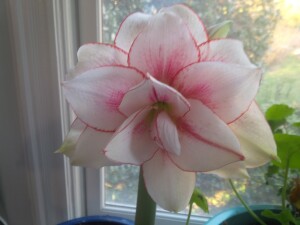 We all have to get through the dark months of the year, when the absence of daylight, the prospect of damp, chilly weather inspires little more than a desire for sleep and sweaters. When we celebrate during at this time of year, we emphasize light in all its forms. I do this as my mother did before me by filling the house with flowers and greenery, sometimes accented with ribbons, lights and tinsel, but always alive and growing.
We all have to get through the dark months of the year, when the absence of daylight, the prospect of damp, chilly weather inspires little more than a desire for sleep and sweaters. When we celebrate during at this time of year, we emphasize light in all its forms. I do this as my mother did before me by filling the house with flowers and greenery, sometimes accented with ribbons, lights and tinsel, but always alive and growing.
Amaryllis, with its habit of being big, obvious and flashy, might seem a little over the top to some people, but I think those people probably define “festive” as a mantle adorned with a burlap bow and two wooden candlesticks.
Fortunately for the rest of us, the marketplace is full of amaryllis, from the old faithful red varieties with their flaring trumpets, to newer types that light up the scene with enhanced traits that may include one or more of the following: double petals, slender petals, shorter stalks, unusual colors, flashy color combinations, or bigger blooms.
The hybrid amaryllis that ornament our holidays may be new, but the ancestor of our modern amaryllis or Hippeastrum hybrids, the red-flowered Hippeastrum reginae, first arrived in Europe in the early eighteenth century. Hybridizing efforts began, and in 1799, Hippeastrum x johnsonii, a reginae offspring, was born. That development energized breeding enthusiasts and by 1830, at least 100 named hippeastrum hybrids had been created.
Like other reliable, showy plants, including tulips, hyacinths and dahlias, amaryllis has ridden repeated waves of popularity throughout the nineteenth, twentieth, and now, twenty-first centuries. Right now, catalogs, garden centers, mass merchandisers and even supermarkets are full of the giant bulbs, either unadorned in bins or packaged in planting kits along with plastic pots and bags of planting medium.
I love just about all amaryllis, especially the traditional forms, with two or three stout stalks bearing enormous flaring trumpets with thick, rounded petals. Some people find this excessive, and for them, the exotic cybister types resonate. Cybister blooms flare out, but the flares are in the form of slender, spidery petals that look like fireworks when all the blooms are open at once. I like the dramatic, red and green cybister ‘La Paz’. For a little less flash, the pale green-petaled ‘Emerald’, with its maroon markings, stands out.
Hybridizers always believe that it is impossible to have too much of a good thing, and that inspiration has produced flower stalks that bear four or more trumpets at once. Though amaryllis stalks are thick, they are not made of rebar and sometimes need staking to avoid collapsing under that weight of the bodacious blooms. Staking tends to irritate the casual indoor plant lover. For that person and everyone else who is too busy at holiday time to fuss with stakes, breeders have come up with miniature amaryllis, with slightly smaller flowers on shorter stems. If you buy a vibrantly-colored variety like the red and white ‘Hot Lips’, the dramatic intensity of hue more than compensates for the smaller size of the plant.
There are years—and this is one of them—when I feel at one with the Oscar Wilde quote, “Nothing succeeds like excess.” That is why I generally purchase at least one double-flowered amaryllis. A big red one like ‘Double King’, or a white wonder, like ‘Arctic Nymph’ makes me feel that life is good and abundance is attainable—at least for a little while.
When my newly-purchased amaryllis finish flowering, I discard the desiccated stalks, continue watering the plants when the top of the soil feels dry, and keep them in an indoor spot, along with other amaryllis that I have saved from years past. When clement weather comes and night temperatures are above 50 degrees Fahrenheit, the amaryllis accompany my other houseplants to sunny spots on my back porch. In the fall they return to the house. I do not make any effort to take the advice of those pundits who recommend forcing the plants into bloom by depriving them of light and water for a certain amount of time. Mine rebloom when they feel ready, which is usually just after the holidays, when life seems bleak and daylight is returning at the usual winter snail’s pace. I have some amaryllis bulbs that have come back for several years running and have even produced “daughter bulbs”, which I detach and plant up on their own. I have high hopes that these daughters will eventually flower as well.
If you feel the need to lighten the mood and brighten the house during the winter months, purchase amaryllis bulbs at your local garden center or mass merchandiser. You can also order from John Scheepers, 23 Tulip Drive, P.O. Box 638, Bantam, CT 06750 ; (860)-567-0838; www.johnscheepers.com . Print catalog available.
